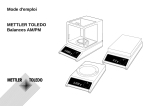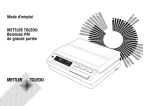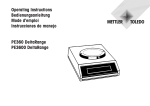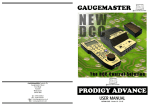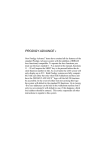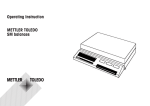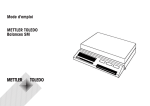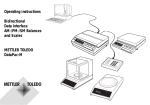Download Mettler Toledo LP16 Operating instructions
Transcript
Operating instructions METTLER TOLEDO AM/PM Balances ; _ 0.0 000 9 ;_ 0.0 ;_ 0.00 0 9 9 2 Thank you very much for the confidence you have shown in our products by choosing a METTLER TOLEDO precision or analytical balance. To obtain complete satisfaction from your balance, it is essential that you read through these operating instructions carefully. These operating instructions apply to balances of the AM and PM series with a weighing range up to 6 kg. Although the operating procedures for these balances are identical, differences exist regarding the weighing range, the readability accuracy and the weighing pan or platform. Enclosed with these operating instructions is the booklet «Technical data and accessories», which also contains possibilities of the METTLER TOLEDO AM/PM balances. Page 4 5 6 Preparation Choosing the location Mounting the weighing pan / levelling the balance Installing the draft shield Operation Control elements / connections / display METTLER DeltaTrac / METTLER DeltaRange Switching display on and off Simple weighing / taring Single-key (control bar) operation 8 9 10 11 12 Menu Overview Calibrating Adapting to the type of weighing (weighing process adapter) Adapting to the ambient conditions (vibration adapter) 14 15 16 17 Configuring Overview Configuration example Standard settings and record printout Balance operating settings Unit selection, applications, print / transfer command, status display Adapting to external equipment Protecting the configuration 18 20 22 24 26 28 30 Applications Overview Switching the weight unit Piece counting Plus / minus and percent weighing Animal weighing Print / transfer command 32 33 34 36 38 39 What if... Fault rectification 40 Miscellaneous Changing the operating voltage / replacing the fuse Changing the protective cover / maintenance Technicals terms 42 43 44 Technical data Overview 45 3 4 Preparation Select the proper location For best results choose a suitable location for your balance. A firm, vibration-free location as horizontal as possible Avoid exposure to direct sunlight No extreme temperature changes 30° 20° 10° 0° No draft Despite a possible unfavorable location, your balance can still produce accurate weighing results: In this case you should adjust the vibration adapter accordingly. For procedures refer to section «Menu». Mount the weighing pan / platform PM balances with weighing pan Place pan support 11 and weighing pan 10 on tapered pin 17; connect power cable 20. 10 11 20 17 0.0 0 9 10 20 11 40 0.0 0 PM balances with weighing platform Install platform support 11 with the four pins resting on the four rubber grommets 40; then position weighing platform 10 on platform support 11; connect power cable 20. 9 AM balances: see page 7. …and now, level the balance 9 8 Preparation After each relocation of the balance, repeat levelling procedures. For this purpose adjust bubble in level indicator 9 with the two levelling screws 8. 8 5 6 Preparation Don't forget to install the draft shield To ensure that the weighing results are not influenced by the drafts (particularly for sensitive measuring ranges) we recommend the installation of a draft shield. PM balances with 1 mg readability Mounting procedures 1 and 2 are needed only if the bottom element 12 has not been installed at the factory. 1 Remove weighing pan 10 and pan support 11. Place bottom element 12 on balance, and rotate to stop. Replace pan support 11 and weighing pan 10. 2 Mount draft shield 13 and engage. 3 AM balances Mount glass draft shield 13 on scale rotated by 45°. Note that tapered pin 17 must be visible through bottom hole 27. Now rotate glass draft shield clockwise to stop. 1 Verify that the draft shield is aligned parallel to the balance and is properly engaged in bayonet base. 2 Install ring 25 and weighing pan 10, close sliding door 26. Note: Ring 25 protects the weighing pan from lateral impacts. 3 Preparation 7 8 Operation Control elements and connections 3 2 4 5 1 8 6 7 8 9 1 2 3 4 5 6 7 8 9 Control bar Program cassette Cover Connector for data interface Connector for METTLER TOLEDO GM instruments Fuse holder (with spare fuse) Power socket Screw feet (level adjustment) Level indicator 31 31a 31b 31c 31d 31e 31f 32 33 34 Status indicator Vibration adapter Weighing process adapter Weight status Automatic zero correction (Autozero) Special status of digital display 1) Stability control Digital display Units METTLER DeltaTrac (dynamic graphic indicator and dispensing aid with 60 radial segments) 1) indicates calculated quantities Tolerance limits 8 Display 31 31a 31b 31e 31f 31c G B N 31d T 35 A Z 8.8.8.8.8.8.8 32 33 34 35 such as mean values or values multiplied by constants, as well as data entered via the interface The METTLER DeltaTrac This dynamic graphic indicator with 60 radial segments is incorporated in all balance models. METTLER DeltaTrac shows you a graphic representation of the numerical values shown in the digital display. With absolute weighing, subtractive weighing, weighing-in and formula weighing, the dynamic display indicates the weighing range used up and that still remaining. With the aid of METTLER DeltaTrac you can check fill quantities and determine deviations from a definable target weight in percent. You can always see the tolerance limits with correct signs, as well as positive or negative deviations (see «Applications»). When used together with METTLER TOLEDO Pacs, the METTLER DeltaTrac can also perform additional functions (see booklet «Technical data and accessories»). METTLER DeltaRange® balances… …include a fin range with 10 times the normal accuracy. Briefly pressing the control bar (taring) will activate DeltaRange anywhere throughout the entire weighing range. Coarse range 10 times more accurate fine range Coarse range Note: You also have the 10 times more accurate fin range available in subtractive weighing. Fine range Weighing range Operation 9 10 Operation Switch on display (▼ Display changes automatically) Display switched off (standby) 8.8.8.8.8.8.8 kg oGNt /k%t G 0.00 B N T A Z PCS Stk 9 104000 . .. Briefly press controll bar; all display segments light up briefly (automatic system and display check). Software No. (e.g. 10.40.00, for information only). -.-.-.-.-.-.-.-.-.-.0.0.0 9 Display subsequently indicates zero (weighing mode). The number of decimal places depends on the readability of your balance model as well as the selected weight unit. Note: If a power outage occurs during operation, the display will indicate OFF immediately the power is restored. You should then briefly press the control bar (also consult «What if…». Switch off display -.-.-.-.0.0.0 9 0.00 9 Weighing mode Lifting the control bar from below causes the display to blank out; the electronics are live as long as the power cable is connected (Standby). The balance is thus always ready for operation; no warm-up time required. Simple weighing Caution: Before the balance is used for the first time, it must be calibrated (see «Calibration» in section «Menu»). -.-.-.-.0.0.0 9 0.00 0.00 9 9 Weighing mode 11 1 8 2 0 3 9 . .. Load weighing sample 1 250009 .. Wait for stability and read result (Stability is reached as soon as stability detector fades). Taring (▼ display changes automatically) Weighing mode -.-.-.-.0.0.0 9 0.00 0.00 9 Load an empty container or packing. 1 1 2 1.01 . . 9 ----- 9 Brief pressing of control bar initiates taring cycle. 9 Tara -.-.-.-.0.0.0 9 The container or packing has now been tared. The weighing range minus tare weight is now available for weighing-in. Note: The stability detector can be switched off during taring by pressing the control bar twice. It is then possible that the display does not show exactly 0.00 g. The foot or hand switch from the accessories offers the possibility of external taring (connection at rear of balance). Operation 11 12 Operation Simple operation with a control bar Switching on/off, calibrating, configuring: All of these operations can be initiated with the control bar. You can even use this single control bar to activate the applications incorporated as standard. For more convenient operation of the applications, the GM303 Terminal (direct function, switch and print key) from the accessories can be used. Note these symbols… …You will find them throughout the operating instructions and short-form instructions. Press control bar briefly Press and hold control bar until required display appears Display changes automatically Introducing the symbols Try to familiarize yourself with the key symbols with the aid of the following example. Switch on the display and remove weight from weighing pan. Now try to select and change the weighing process adapter 31b. -.-.-.-.0.0.0 9 Press control bar… 15-cal. . …keep depressed… 31b …release! briefly press control bar! Note: If the display automatically returns to zero (weighing mode) 3 seconds after the control bar was last pressed, simply begin the procedure again. Have you adjusted the status display so that the «drop symbol» is shown on the left of the display? If your first attempt was unsuccessful, try again. You will find further information regarding the weighing process adapter and much more in the following sections. Operation 13 14 Menu A clear Menu We distinguish between two levels of software. The first, simpler level, we call the Menu. It can be activated by pressing and holding the control bar. The second software level is called the Configuration file. Details can be found in section «Configuring». When the Menu is activated, you can… 15-cal. . …calibrate your balance, …use the weighing process adapter to set the weighing modes or the weighing sample, and 0.00 9 …use the vibration adapter to adapt the balance to the ambient conditions. You can select the menu from the weighing mode. Switch on display and remove load from weighing pan. Then press control bar (and keep depressed): The menu sequence starts. After the third menu step the balance returns to the weighing mode. Now release the control bar. Note: If you have selected the menu step «Weighing process adapter» or «Vibration adapter» and do not press the control bar for 3 seconds, your balance will return automatically to the weighing mode. However, the actual settings are stored (the same applies if you return to the weighing mode by pressing and holding the control bar). 15-cal- Calibrate your balance Before the balance is used for the first time, it must be calibrated (to take the acceleration due to gravity into account). Caution: To obtain accurate results we recomment that you connect the balance to the line 30 min before calibrating (60 min for AM balances). 0.00 -.-.-.-.0.0.0 9 Start calibration with display switched on by pressing and holding the control bar (weighing mode, display zero with empty weighing pan). 9 15-cal. . Release control bar as soon as –CAL– appears in display. -.-.-.-.-.-.-.0 01 0 0 0 0 0 9 . . . . .. . 0.00 -.-.-.-.-.-.-.- 9 00400009 .. . .. . 0.00 Required calibration weight, e.g. 1000.00 g, flashes. Place required calibration weight on balance. Prompt to remove weight. -.-.-.-.-.-.-.- Remove weight from balance. -.-.-.-.0.0.0 9 The balance is recalibrated, (it is now back in weighing mode). 9 Menu 15 16 Menu Adapt your balance to the type of weighing (Weighing process adapter)… Access -.-.-.-.0.0.0 9 Weighing mode 15-cal. . With this adapter you will optimize the display speed of the last digits as a function of weighing mode: For instance, for fine dispensing of powders even the last place of the digital display must be continuously recognizable. This is not the case for absolute weighing; the weighing process adapter thus suppresses the display during the weighing process. The result with all decimal places will appear only when it is stable. Weighing process adapter Adjustments Weighing process Fine dispensing (weighing-in) of fine powder or small quantities of liquids Universal Absolute weighing Animal weighing Remarks For slow filling-in of weighing goods all decimal places of the display are available. The weight increase can thus be followed easier. Standard setting. With DeltaDisplay –on– , the last decimal place is suppressed in coarse dispensing, see page 25. In this setting, you can rapidly check a weight. Only the final result appears in the display. «------» is displayed during the unstable phase. Your balance is now operating in the animal weighing mode, e.g. movements of a live animal do not influence the display. The measurement values are averaged during a certain time period and subsequently indicated on the display. Starting of measuring cycles and setting of measuring time are explained in section «Applications, animal weighing». …as well as to the ambient conditions (Vibration adapter) Access -.-.-.-.0.0.0 9 Weighing mode 15-cal. . Under vibration-free conditions adjust the adapter to obtain results within the shortest possible time. However, if you are operating in an environment with severe vibrations or drafts, adjust the adapter to obtain reliable results, even under adverse conditions. Vibration adapter Adjustments Weighing environment Remarks Very quiet and stable Whit this setting your balance operates very fast (short weighing cycle), but the balance is relatively sensitive to ambient disturbances. Normal Standard setting Unstable, e.g. draft or strong building vibrations Your balance is not sensitive to external disturbances, however, its operation is slowed down. Menu 17 Configuring 18 Special requirements need special settings within the configuration file Your balance has been factory-set to a standard configuration, i.e. the settings in the configuration file correspond to the most common user requirements. If you wish to change these settings to meet special requirements you must access the configuration file and change the settings according to your needs. The configuration file is divided into four sectors, in which you can change the follwing settings: ¨eseT Standard setting and record printout yes Resetting to standard configuration li sT Printout of balance specification values and actual configuration (printer connected) s c al e Setting balance operating parameters as D Changing stability detector (four settings) D . Reducing readability DD . Switching off METTLER DeltaDisplay AZ Switching off automatic zero correction uNI T Unit selection, applications, etc. uNI T1 Selection of basic unit uNI T2 Selection of second unit and applications p¨TT2 Print/transfer command / Starting animal weighing mode Switch on status displays i -face Adapting to peripheral units s . Transmission mode 6 Baud rate p Parity pause Pause between data transfers and handshake Please see the following pages for more information on the individual setting possibilities. Note: Short-form operating instructions are enclosed with this operating manual and show the configuration file with all possible settings. These short-form instructions are intended for use as an overview aid in your day-to-day work. Configuring 19 Configuring Configuring – a quick introduction ------- Access Start from standby, i.e. display switched off. Now, press control bar and release only when display shows –Conf.–. Display now automatically changes over to –Reset–. -cONf¨eseT ¨ e s e T s c a l e Selecting sectors The 4 sectors can be selected by briefly pressing the control bar. Note: The –End– display between the sectors –I-Face– and –Reset– indicates the end of the four sectors. , u N I T i - f a e N D c e uNI Te uNI T1 g Selecting adjustment For instance in sector –Unit–: Keep control bar depressed unit the desired selection is displayed (e.g. –Unit 1–). 20 Have you found the setting –Unit 1–? If not, switch off the display by lifting the control bar. Then restart by accessing the configuration file. This time it's sure to work. uNI T1 Change setting, e.g. from –g– (gram) to –ct– (carat): Briefly press control bar several times until carat (ct) appears in display. g Press briefly x times uNI T1 CT uNI T1 CT uNI T2 g p¨ TT2 oFF Auto e ND 0.0 0 Return to weighing mode After completing your configuration keep control bar depressed until zero indication appears (weighing mode). The effective settings are now stored, and you can proceed with your weighings. Note: If you release the control bar at –End– (each sector is terminated with –End–) and then press briefly, you will return to the start of the corresponding sector (e.g. –Unit–). 9 If, after making these changes, you would like to return to the standard configuration, please turn to the next page. The following pages also tell you everything you wish to know regarding the individual setting options. A general overview of the configuration file is available from the enclosed short-form operating instructions. Configuring 21 22 Configuring ¨eseT Standard setting and record printout Access Symbols Standby -------cONf- Press control bar briefly Press and hold control bar until required display appears Display changes automatically ¨eseT Important Return to weighing mode by keeping control bar depressed until zero indication appears. If you do not press control bar for 40 sec, the balance will automatically return to weighing mode. ¨eseT Settings NO y e sT 88 Standard setting Yes / No For resetting your balance to standard configuration, select sector –reset–. Now press control bar until –yes– is displayed. By pressing and holding the control bar again until –End– or zero appears, you acknowledge the resetting (weighing mode appears after –End– indication). Your balance is now reset to the original factory setting. Printout of balance specifications and the actual configuration Yes / No? To obtain a printout of balance specifications and the selected settings in the configuration file, select –ON–. Acknowledge the List command by pressing and holding the control bar until – – – – – – appears. The record with the following values can be printed out with an attached printer (e.g. METTLER TOLEDO GA44): l i s T 88 NOl i s T - - ---***************** STANDARD V10.20.00 TYPE : SM.1220 INR : 0 FULL d : = RANGE : d CAL = : 12009 g 1 g 2000.0 g 0.1 g 4000.0 g ***************** Balance specification values Actual configuration • • • • • • • • • • • • • • • • • • • STANDARD TYPE INR FULL d CAL Software version, e.g. V.10.40.00 Stock designation, e.g. PM2000 Indentification No., 7 digits Weighing range, e.g. 2100.90 g Readability, e.g. 0.01 g Calibration weight value eND ASD d dd AZ Unit 1 Unit 2 Prt [][] S b P PAUSE AU Stability control, e.g. step 2 Readability, e.g. 0.01 g Delta Display, e.g. on Automatic zero correction, e.g. on Basic unit, e.g. g Second unit, e.g. g or applications e.g. pcs Print/transfer command, e.g. off Status display, e.g. auto Transmission mode, e.g. Stb Baud rate, e.g. 2400 baud Parity, e.g. –E– Pause duration between data transfer, e.g. 1 s Suppress special characters, e.g. on scal e Configuring 23 24 Configuring scal e Setting balance operating parameters Access Standby Symbols Press control bar briefly -------cONf- Press and hold control bar until required display appears ¨eseT Display changes automatically scal e asD -2- Standard setting -3- Selectable setting Important Return to weighing mode, always with control bar depressed till zero indication. If you do not press control bar for 40 sec, the balance will automatically return to weighing mode. Modified settings will be recorded. Settings scal e as D88 -2-D -3-D -1-D -4-D Automatic stability detection The stability detector 31f lights up when the balance is unstable. At the same time, the data interface is blocked until the weighing result is stable (except for data transfer mode «S» being set to –All– or –Cont–; see sector –I-Face–). -1-D Weighing speed: very fast Reproduction: good -2-D -3-D -4-D D. D88 0.1 0.2 10 0.5 5 1 fast very good Selection of display sequences (Readability) Example for 0.1-g balances: Step (d) 1 2 5 Display (g) 0.1 0.2 0.5 10 1 20 50 2 5 100 10 2 DD. 88 ON1 Off Weighing-in aid (DeltaDisplay) switching on or off The DeltaDisplay is a weighing-in aid for fast and accurate weighing-in. Decimal places are reduced by one as a function of weighing-in speed. During the final phase of the weighing-in process the balance automatically switches over to normal weighing: ON1 AZ ON1 Off Off switch off Automatic zero correction (Autozero) switching on or off Autozero automatically compensates for zero drift or soiled pan. ON1 eND switch on switch on Off switch off Note: The symbol –AZ–, in either position (on/off), appears only in the configuration file. Configuring 25 26 Configuring uNI Tf- Unit selection, Applications, Print/Transfer command, Status display Access Symbols Standby Press control bar briefly -------cONf- Press and hold control bar until required display appears ¨eseT Display changes automatically scal e uNI T1 uNI Tf- g Standard setting kg - Selectable setting Important Return to weighing mode always with control bar depressed until zero indication. If you do not press control bar for 40 sec, the balance will automatically return to weighing mode. Modified settings will be stored. Setting options uNI Te uNI T1 uNI T2 p¨ T g kg g lb k oz C.M. ozt ct tl dwt GN g x times g PCS % Stk Off ON aUTO ON Basic weighing unit In addition to the weight unit g, the following weight units can be selected for weighing: tl gram kilogram pound ounces troy ounces tael kg g ozt oz lb carat no unit display (display value in g) dwt pennyweight ct C.M. k GN grain Note: The number of decimal places depends on the balance model and selected weight unit (see «Decimal places for secondary units» in the booklet «Technical data and accessories» and «Conversion factors» in the section «Applications» under «Switching weight unit»). Switchable second unit –Unit 2– includes the same weight units as basic unit. In addition you may select: Piece counting Plus/minus or percent weighing PCS % Stk For further information regarding these applications, see section «Applications». Switch print / transfer command on or off Print of the indicated weight value or initiation of transfer command with control bar. off switch off ON switch on If operating in animal weighing mode, you can initiate a new measuring cycle with the control bar. For additional information see section «Applications». Switch status indicator on or off auto 3 minutes after switching on balance, the two status indicators fade automatically ON Auto: The two status indicators remain active, i.e. they are always visible on display. eND Configuring 27 28 Configuring i -face Adaptation to external equipment Access Symbols Standby Press control bar briefly ------- Press and hold control bar until required display appears -cONf- Display changes automatically ¨eseT scal e s . I T1 sTB Standard setting all Selectable setting uNI Tfi -face Important Always return to weighing mode by keeping control bar depressed until zero indication appears. If you do not press control bar for 40 sec, the balance will automatically return to weighing mode. Changed setting will be stored. General information All METTLER TOLEDO precision or analytical balances are factory-equipped with a bidirectional interface (CL and RS232C). For detailed information see operating instructions «Bidirectional Interfaces for PM balances». (See also «Miscellaneous, Auxiliary equipment»). Data format of balance interface: 1 start bit, 7 data bit, 1 parity bit, stop bit automatic (1 RX / 2 TX) Setting options i -face s . I T1 sTB all cONT aUTO Datenübertragungsmodus sTB all aUTO cONT B . I T1 2400 4800 1200 x times Baud rate The baud rate is the transfer rate unit for serial data transmission in bit/sec: 110 p . I T1 pa u s e aU eND -e- -o- -s- -m- 1 2 h .0 Off ON The next possible stable value is transferred after initiation of print/transfer command (after release by stability detector). The current value (dynamic «SD» or stable «S») is transferred after initiation of print/transfer command. Only stable values are transferred after every change of weight (necessary change 1 g. Exceptions: PM6: 5 g and AM50/AM100: 0.2 g. For animal weighing see section «Applications»). All values (dynamic «SD» and stable «S») are transferred automatically. 150 300 600 1200 2400 4800 9600 Parity Parity control permits recognition of simple bit errors in data transmission: -e- even parity -o- odd parity -m- mark parity -s- space Pause between transfers and handshake (hardware related for RS232C) Settings –Pause 0–, 1 and 2 permit the adaptation of transfer rate to data receivers working at different rates (specifications in seconds). –Pause H– evaluates the hardware related hanshake signal for RS232C. The balance is ready for handshake mode operation. Caution: For handshake mode operation the transfer input may not be used. Certification symbol in data transmission If balances are connected to peripheral units that can not process the certification symbol ( <…>, * ) (e.g.LP16-M Infrared Dryer and SQC systems) or if a printout of these characters is not required, the function –Au– must be set to –on–. Configuring 29 Configuring How to protect the new settings in the configuration file After having completed your configuration, you can protect your settings against inadvertent changes. Proceed as follows: To protect the program cassette from possible interface, it is absolutely essential to first disconnect the line cable 20. 1 Now remove cover 3, for instance with a screwdriver. The program cassette is now visible. 2 Grasp bracket of program cassette 2, and carefully pull out cassette. 3 30 In the aperture of the program cassette 2, the shorting jumper 24 is now visible. It can be lifted off from the contact pins (e.g. with a small pencil). 4 not secured To protect your settings in the configuration file from involuntary changes, position the jumper across both contact pins (position secured). secured 5 Reinsert the program cassette 2. Ensure that you push it in firmly right to the stop. Then press on the protective cover 3. Connect power cable 20. 20 6 3 2 Your settings are now secured, i.e. accessing the configuration file is no longer possible. If you wish to remove the security provision, follow the sequences shown in Figures 1 to 4. In Figure 5 select the position «not secured». Configuring 31 32 Applications Standard applications at a keystroke Counting in or out of a container, percent formula weighing of powders or liquids, plus/minus checks of fill quantities, weighing in grams or in a second, selectable unit, or even animal weighing: all this and more can be performed with the applications built in as standard. You can choose between the following applications: g ct 175 PCS Animal weighing Animal weighings can also be performed simply and rapidly. Changing weight units You can switch between two selected weight units, e.g. between gram and carat. Piece counting The balance can be used for piece counting; 10 is the fixed reference value. Print/transfer command Print/transfer command can be initiated with the control bar. p¨INT Symbols % Plus/minus and percent weighing The balance can also be used for plus/ minus checks. If your balance is used for checks in %, the METTLER DeltaTrac indicates the deviation from the preset target weight, the tolerance limits of +/2,5 % and their violations. You can of course perform the usual percent weighings simply and rapidly. Press control bar briefly Press and hold control bar until required display appears Display changes automatically g ct Switching weight unit Configuration Working with two units Standby u N 0. I 00 9 uNI T CT Basic unit, e.g. –g– (gram) ------- till -cONf0.00 ¨eseT scal e 9 In the configuration file, select the setting –Unit 1– in the –Unit– sector: The standard setting has the basic unit gram (g). If you wish to change this, press the control bar repeatedly until the desired unit appears. uNI till uNI Tf- 0.00 uNI T Press briefly x times Basic unit u N I0.0 0 Now press control bar until –Unit 2– appears: Select desired second unit (e.g. –ct–) by briefly pressing control bar (e.g. –ct–). u N I T 2 TT u N I0.0 0 9 9 9 uNI T19 uNI T29 Second unit, e.g. –ct– (carat) 0 CT Return to weighing mode 9 Conversion factors ounce pound pennyweight troy ounce grain carat tael Applications 1 oz 1 lb 1 dwt 1 ozt 1 GN 1 ct 1tl ≈ ≈ ≈ ≈ ≈ = ≈ 28.349523125 453.59237 1.55517384 31.1034768 0.0647989 0.2 37.4290 g g g g g g g 1g 1g 1g 1g 1g 1g 1g ≈ ≈ ≈ ≈ ≈ = ≈ 0.035273962 0.002204623 0.643014931 0.032150747 15.43235835 5 0.026717213 oz lb dwt ozt GN ct tl 33 34 Applications 175 PCS Piece counting (fixed reference number – 10 pieces, 1 item at least 1/4 digit) Configuration Standby Counting into a container ------0.00 9 u N I0.0 0 9 Place empty container onto balance, tare u 6 5 .8 7 9 Add 10 items to container (to obtain reference) -cONf- 10 ¨eseT Select –Unit 2– in sector –Unit– of configuration file 0.00 scal e 9 uNI Tf- till s e T 1.0 PCS u N I 1.0 PCS 9 Press control bar until –SEt 10 PCS– appears (reference will be stored) uNI T19 uNI T29 Press briefly x times uNI T2 Now changes this setting to –PCS– (piece counting is now effective) 0.00 PCS u N I0.0 0 9 Return to weighing mode 9 u 4 1 7.5 PCS Add quantity to be determined Switch piece count/weight readout Counting out of a container 8.8.8.8.1.7.5 Return to weighing mode uNIT 8.8.8.8.1.7.5 0.00 9 u N I 0.0 0 9 9 - 6 5.8 7 9 g 1.1.5.2.7.3 uNIT PCS 10 g PCS Place filled container on balance, tare 0.00 Select piece counting PCS till 0.00 0.00 Applications s e T 1. 0 PCS u N - 1.0 PCS u - 1 7.5 PCS 9 9 Remove 10 items (reference) Press control bar unit –SEt 10 PCS– appears (reference is stored) Take out quantity to be determined 35 36 Applications % Plus/minus and percent weighing (tolerance limit ± 2,5%, 100 % = target weight, min. weight = 100 digit) Configuration Set target weight Standby 5 0 0 .0 0 0.00 ------- till -cONf- ¨eseT 0.00 9 9 seT 1 0 0% 9 - 1 0 0.0 0 % Place target weight on pan Press control bar until –SEt 100 %– appears (target weight will be stored) Select –Unit 2– in sector –Unit– of configuration file scal e 0.00 u - 1 0.0 0 % Remove target weight 9 uNI Tf- Checkweighing uNI T19 Target uNI T29 Press briefly x times Now changes this setting to –%– by briefly pressing control bar (plus/minus or percent weighing is now effective) uNI T2 % u N 0. I 009 Return to weighing mode -2.5% 0.00 9 100% +2.5% Place weighing sample on pan and check if weight is within tolerance limits Switch percent weighing/weighing mode 9.8.7.0 Coarse weighing-in u N I 0.0 0 % % 0.00 g uNIT 4.9.3.5.0 9 g g u 4 6 7.4 0 % uNIT % % 0.00 9.8.7.0 Place empty container on balance, tare coarse indicator 9 Add weighing sample rapidly; the coarse indicator moves downward (coarse indicator position six o'clock = target weight) % Fine weighing-in fine indicator Number of decimal places as a function of reference weight Reference (digit) Display (%) Display increments < ≥ ≥ ≥ ≥ ≥ ≥ –Err 3– 100 100.0 100.0 100.0 100.00 100.000 – 1 0.5 0.2 0.1 0.01 0.01 100 100 200 500 1000 10000 100000 0.00 u 4 9 8.7 0 % Add weighing sample gradually; the fine indicator moves upward (fine indicator position 12 o'clock = target weight) 9 Target weight 0.00 Applications u 1 0 0.0 0 % 9 When fine and coarse indicators from a vertical line, the target weight has been reached (± 0,25%) 37 38 Applications Animal weighing Configuration , Set weighing process adapter 31b to «Animal weighing» - Use vibration adapter 31a to select the desired time cycle (integration time + reading time): Manual • With the external transfer keys (see booklet «Technical data and adcessories») • With the control bar of your balance (set print command to –Prt on–, see «print/transfer command» in this section): 7 5 0 8.3 0 — 3 sec. _ 5 sec. See also section «Operation». The various displays have the following meanings _, Balance ready tor animal weighing _, Weighing cycle in process (integration time) - - - -.- 9- * _, 7 5 0 2.3 5 9 9 – 7 sec. _, 7 5 0 8.3 0 9 Press control bar until –Start– appears. _, Read result (Available reading time: Display remains stable for 3…5 sec) T s T a. 9 ∂ When the control bar is released, the weighing cycle starts. Note: If a printer is connected, the stable weight value is printed out automatically. Automatic • Set data transfer mode «S» to –Auto– (see also «Configuration, Sector –I-Face–»). Placing a live animal on the weighing pan automatically initiates a weighing cycle. To initiate a new weighing sequence, the load on the balance between two animal weighings must be reduced to less than 2 g for 0.1 mg balances, 10 g for 0.1 mg/10 mg and 100 mg balances, 50 g for g-balances. Note: For DeltaRange balances select smallest unit as a reference. p¨INT Print/transfer command Configuration Initiate print/transfer command Standby 2 5 2 .1 0 ------- 9 Press control bar until –Print– appears in the display. Weighing results are now printed out by an attached printer. Transfer commands may be initiated as well. -cONfp¨INT ¨eseT scal e Select –Prt off– in sector –Unit– of configuration file. Note: If your weighing process adapter 31b is set to «Animal weighing», the readout shows –Start– in place of –Print– (see also «Animal weighing» in this section). uNI Tf- uNI T19 uNI T29 p ¨ T O.f.f p ¨ T O.N Now changes this setting to –Prt on– . The print/transfer command or start command for animal weighing is now switched on. Return to weighing mode. u N 0. I 009 Applications 39 40 What if… A breakdown should occur anyhow Display Definition Cause Correction Display blank - No Power Scale switched off Power cable disconnected Temporary disturbance - - Incorrect operating voltage Line fuse defective In case of repetition Pan support or/and pan not in place - Zero not defined < - - - 0.0.0 9 <-----> ∂™™™™™ƒ - Off- < - - - 2.0 4> Underload Overload Power loss Weighing result unstable - Pan support or/and pan not in place - Protective cover touching pan support - Lower limit of weighing range violated - Upper limit of weighing range exceeded - Poer cable connected with display swiched on - Temporary power failure - Unstable weighing location - Unsteady object on balance (e.g. animal) - Excessive draft < - - - 2.0 3 > - Incorrect operating voltage Check power system; Switch on scale Connect power cable Switch scale off/on, or pull out/plug in power cable Correct voltage setting, see «Miscellaneous» Replace fuse, see «Miscellaneous» Inform METTLER TOLEDO Service Place pan or/and pan support on balance - Place pan or/and pan support on balance - Mount protective cover properly, see «Miscellaneous» - Tare - Reduce load - Tare - Check power connector is properly connected, then tare - Adjust vibration adapter, see «Operation» - Place scale on stable support - Set weighing process adapter to animal weighing mode, einstellen, see «Operation» - Install draft shield (standard accessory for AM balances and balances with 1 mg readability) - Correct voltage setting Display <i 1 5 5.4 3 9 Definition Cause Correction Incorrect result - Operational error - 1 kg e¨¨1 Unstable when taring, calibrating or setting reference - Wrong unit - Protective cover touching pan support - Weighing sample touching housing or draft shield - Excessive draft or vibration - Stability detector setting too sensitive e¨¨2 e¨¨3 e¨¨O¨0 till Taring in overload or underload condition - See overload/underload Reference insufficient - Reference is too small or missing (piece counting , plus/minus or % weighing) - Program cassette improperly inserted - Admissible temperature range exceeded Error message from internal electronics monitor during automatic self check - - Take off weight, tare and repeat weighing Check levelling, see «Preparation» Check calibration, see «Operation» Select correct unit, see «Configuring» Mount protective cover properly, see «Miscellaneous» Rearrange weighing sample to avoid contact with housing or draft shield Install draft shield (standard accessory for PM100. AM balances and balances with 1 mg readability) Close sliding window (AM balances) Adjust vibration adapter, see «Operation» Adjust stability detector, see «Configuring» - Increase weight/ reference weight - Insert program cassette correctly - Pull out/plug in power cable - If error message persists, contact METTLER TOLEDO Service e¨¨O¨9 What if… 41 Miscellaneous 42 How to adjust the operating voltage 10 11 20 17 21 22 0.0 0 9 10 20 11 22 21 40 0.0 0 9 Make sure the power cable 20 is disconnected. With the power cable connected, the inside of the balance is live even if the display is blank! Lift off weighing pan 10 and pan support 11; remove screw 21 and carefully lift off upper section of housing 22. Reset voltage selector 23 with a screwdriver. Carefully lower upper section of housing 22 vertically onto the balance. Replace screw 21 and tighten, place pan/platform support on tapered pin 17 or the four rubber grommets 40. Finally, place the weighing pan or platform 10 on its support 11 and connect power cable 20. Caution: Change microfuse after changing operating voltage (see below). Changing the microfuse – in a trice The spare fuse is in the fuse holder 6. Fuse ratings: 115 V = 125 mA slow blow 230 V = 63 mA blow 20 6 Disconnect power cable. Lever out fuse holder 6 using a screwdriver. Remove blown fuse and insert a new one. Reinsert fuse holder 6. Reconnect power cable 20. Do not forget to order a new spare fuse. How to change the protective cover 10 11 10 11 0.0 12/15 16 0 41 16 0.0 0 9 9 A soiled protective cover can be exchanged as follows: Lift off weighing pan 10 and pan holder 11. For balances with round weighing pan, rotate bottom plate 12 or retaining ring 15 until disengaged, lift off. Position balance on its side. Remove control bar 1 by applying pressure toward A. It will disengage and can be lifted off in the direction of B. Remove protective cover 16. Installation of new protective cover for balances… …with weighing pan Fit new protective cover 16. Slide on control bar 1. Position bottom plate 12 or retaining ring 15 and rotate until engaged. Replace pan support 11 and weighing pan 10. A B A 1 …with weighing platform Before mounting the new protective cover 16, the two protective foils must be removed at the adhesion points. Next, to attach the new protective cover 16 at rear of balance and press down in front. Briefly press the two adhesive spots 41 against upper section of housing. Slide on control bar 1, replace platform support 11 and weighing platform 10. Easy to clean For cleaning the stainless steel pan, a cloth with soap and water is adequate. Never use powerful solvents. NITRO Caution: Never position balance upside down (damage to measuring cell)! Miscellaneous 43 Miscellaneous 44 You can't know all the words Calibrating Adapting the balance to a reference weight LCD Liquid crystal display Configuration cycle A run through the configuration file Menu Configuration file A second level, lockable with the jumper with variable parameters and selectable applications as additions to the menu, see «Configuring» The first level, consisting of calibration, adaptation of weighing process and vibration, can be extended with applications, see « Operation» and «Applications» Reproducibility The similarity of values obtained from repeated weighings on the same balance under the same conditions of measurement Sector 1 Configuring The setting of parameters, see «Configuring» Control bar A single operating device for weighing, working through the menu and configuring your balance DeltaDisplay An aid to fast, accurate weighing-in, see «Configuring» Segment A radial bar, 1/60th of the DeltaTrac Standard setting The settings for normal user requirements DeltaRange Selectable fine range, see «Operation» Standby DeltaTrac A dynamic graphic indicator with 60 radial segments, see «Operation» The balance is ready for use (power cable plugged in) but not switched on, i.e. display is blank Tare weight The weight of weighing vessels or packaging /4 of the DeltaTrac, comprising 15 segments Digit (d) The smallest displayed value (e.g. METTLER TOLEDO PM3000: 0.1 g) Taring Allowing for the tare weight(s), i.e. the digital readout shows zero Dispensing Precise weighing-in of powder or small amounts of liquid Vibration adapter A means of adapting the balance to is location, see «Operation» Display The entire display unit, see «Operation» FD Fluorescent display Indicators These indicate the status of the balance, see «Operation» Weighing process adapter A means of adapting the balance to the materials weighed, see «Operation» Weighing range, e.g. 2100.90 g Readability, e.g. 0.01 g Calibration weight value Jumper A small connector for locking the configuration, see «Configuring» Technical data for individual models AM50 AM100 PM100 PM200 PM400 PM1200 PM5003 PM480 Comparator DeltaRange PM2500 DeltaRange 0.1 mg 0.1 mg 0.001 g 0.001 g 0.001 g 0.001 g 0.001 g 0.01 g 0.01 g - - - - - - - 0.001 g 0.001 g 51 g 110 g 110 g 210 g 410 g 1200 g 5100 g 410 g 2100 g - - - - - - - 80 g 500 g Taring range (by subtraction) 51 g 110 g 110 g 210 g 410 g 1200 g 5100 g 410 g 2100 g Reproducibility (s) 0.1 mg 0.1 mg 0.5 mg 0.5 mg 0.001 g 0.001 g 0.0015 g 0.003 g 0.003 g - - - - - - - 0.001 g 0.001 g ± 0.2 mg ± 0.2 mg ± 0.002 g ± 0.002 g ± 0.002 g ± 0.002 g ± 0.01 g ± 0.005 g ± 0.005 g - - - - - - - ± 0.002 g ± 0.002 g Sensitivity drift / °C (10 … 30 °C) 2 x 10-6 2 x 10-6 4 x 10-6 4 x 10-6 3 x 10-6 1.5 x 10-6 2 x 10-6 4 x 10-6 1.5 x 10-6 Stabilization time 1) 2.5/4/6 s 2.5/4/6 s 1.5/2/3 s 1.5/2/3 s 1.5/2/3 s 2.5/4/6 s 9/12/15 s 1.5/2/3 s 2.5/4/6 s Update speed 0.13 s 0.13 s 0.13 s 0.13 s 0.13 s 0.13 s 0.13 s 0.13 s 0.13 s Display 2) FD FD FD FD FD LCD LCD FD LCD in inclined position (1:1000) 0.5 mg 0.5 mg 0.005 g 0.005 g 0.005 g 0.005 g 0.02 g 0.005 g 0.005 g Weighing pan Ø 80 mm Ø 80 mm Ø 130 mm Ø 130 mm Ø 130 mm Ø 130 mm Ø 130 mm Ø 130 mm Ø 130 mm Calibration weight 3) 50 g/E2 100 g/E2 100 g/F1 100 g/F1 200 g/F1 1000 g/E2 5000 g/E2 100 g/F1 1000 g/F1 Net weight 6.0 kg 6.6 kg 3.8 kg 3.8 kg 3.8kg 3.8 kg 3.8 kg 3.8 kg Balance housing (W x D x H) in mm 194 x 316 x 252 194 x 316 x 337 194 x 316 x 68 Power consumption 6 VA Fusing 63 mA/220 V Readability - Fine range (recallable) Weighing capacity - Fine range (recallable) - Fine range Linearity - Fine range Result deviation 6.6 kg 194 x 316 x 337 194 x 316 x 68 125 mA/110 V Technical data 45 46 Technical data PM300 PM600 PM2000 PM4000 PM6100 PM4800 PM3000 DeltaRange PM6000 PM6 0.01 g 0.01 g 0.01 g 0.01 g 0.01 g 0.1 g 0.1 g 0.1 g 1g - - - - - 0.01 g - - - 310 g 610 g 2100 g 4100 g 6100 g 4100 g 3100 g 6100 g 6100 g - - - - - 800 g - - - Taring range (subtraktiv) 310 g 610 g 2100 g 4100 g 6100 g 4100 g 3100 g 6100 g 6100 g Reproducibility (s) 0.003 g 0.005 g 0.005 g 0.01 g 0.01 g 0.03 g 0.03 g 0.05 g 0.3 g - - - - - 0.01 g - - - ± 0.01 g ± 0.01 g ± 0.02 g ± 0.02 g ± 0.02 g ± 0.05 g ± 0.1 g ± 0.1 g ±1g - - - - - ± 0.02 g - - - Readability - Fine range (recallable) Weighing capacity - Fine range (recallable) - Fine range Linearity - Fine range -6 -6 -6 -6 -6 -6 -6 -6 Sensitivity drift / °C (10 … 30 °C) 4 x 10 6 x 10 4 x 10 3 x 10 3 x 10 4 x 10 4 x 10 6 x 10 6 x 10-6 Stabilization time 1) 1/1.5/2.5 s 1.5/2/3 s 1.5/2/3 s 1.5/2/3 s 2.5/4/6 s 1.5/2/3 s 1/1.5/2.5 s 1/1.5/2.5 s 1/1.5/2.5 s Update speed 0.13 s 0.13 s 0.13 s 0.13 s 0.13 s 0.13 s 0.13 s 0.13 s 0.13 s Display 2) FD FD FD FD FD FD FD FD FD 0.01 g 0.05 g 0.05 g 0.05 g 0.05 g 0.05 g 0.5 g 0.5 g 1g Ø 130 mm Ø 150 mm Ø 150 mm Ø 170 mm Ø 150 mm Ø 170 mm 182 x 228 182 x 228 182 x 228 100 g 500 g 1000 g 2000 g 2 x 2000 g 1000 g 1000 g 2000 g 2000 g Net weight 3.8 kg 3.8 kg 3.8 kg 3.8 kg 3.8 kg 4.2 kg 4.2 kg 4.2 kg Balance housing (W x D x H) in mm 194 x 316 x 68 Power consumption 6 VA Fusing 63 mA/220 V Result deviation in inclined position (1:1000) Weighing pan Calibration weight Class F1 3) 3.8 kg 125 mA/110 V 1) 2) 3) dependent on the setting of the vibration adapter _ FD Fluorescent display, self-luminous LCD Liquid crystal display, passive for noncertified version Printed on 100 % chlorine-free Paper, for the sake of our environment. To protect your METTLER TOLEDO product's future: METTLER TOLEDO Service assures the quality, measuring accuracy and preservation of value of all METTLER TOLEDO products for years to come. Please send for full details about our attractive terms of service. Thank you. P702395 Subject to technical changes and to the availability of the accessories supplied with the instruments. © Mettler-Toledo GmbH 1999 702395C Printed in Switzerland 9910/2.12 Mettler-Toledo GmbH, Laboratory & Weighing Technologies, CH-8606 Greifensee, Switzerland Phone +41-1-944 22 11, Fax +41-1-944 30 60, Internet: http://www.mt.com
















































